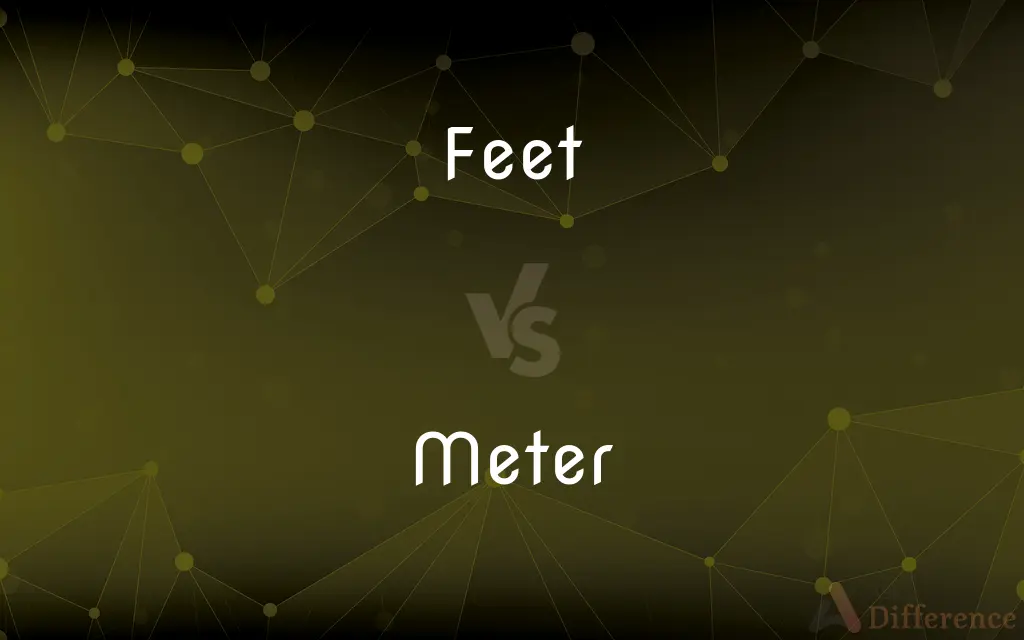Feet vs. Meter — What's the Difference?
By Fiza Rafique & Maham Liaqat — Updated on March 20, 2024
Feet is a unit of length in the imperial system, while meter is the base unit of length in the metric system.

Difference Between Feet and Meter
Table of Contents
ADVERTISEMENT
Key Differences
Feet, denoted by 'ft', is a unit of length in the imperial system, used primarily in the United States and a few other countries for everyday measurements. The meter, symbolized as 'm', is the base unit of length in the International System of Units (SI), adopted worldwide for scientific and most international applications.
One foot is defined as exactly 0.3048 meters. The use of feet is common in contexts such as the measurement of height, short distances, and real estate. Meters, being part of the metric system, are used in a wide array of applications from everyday measurements like the height of a person to scientific endeavors, emphasizing their versatility and universal acceptance.
The transition from using feet to meters in countries that traditionally used the imperial system reflects a global shift towards standardization and ease of international communication and trade. While feet continue to be used for cultural and practical reasons in some regions, the meter’s adoption is almost universal in scientific research, which necessitates precise and standardized measurements.
Measurements in feet are often represented in whole numbers and fractions, making them intuitive for everyday use in certain contexts, such as measuring height or the size of a room. On the other hand, meters can easily be converted into larger or smaller units within the metric system, such as kilometers or millimeters, by multiplying or dividing by powers of ten, showcasing the metric system’s simplicity in calculations and conversions.
Despite the differences, understanding the conversion between feet and meters is crucial in a globalized world, especially in fields like engineering, aviation, and international trade, where clear and accurate communication of measurements is essential.
ADVERTISEMENT
Comparison Chart
System
Imperial
Metric (SI)
Symbol
Ft
M
Defined as
0.3048 meters
The base unit of length in SI
Usage
Primarily in the US and a few other countries for everyday measurements.
Worldwide for scientific, engineering, and most international applications.
Conversion
1 ft = 0.3048 m
1 m = 3.28084 ft
Representation
Often in whole numbers and fractions
Decimal system, easily scalable (mm, cm, km)
Compare with Definitions
Feet
Preferred in certain industries like aviation for altitude in the US.
The airplane is cruising at 35,000 feet.
Meter
Reflects a global trend towards metrication for ease of trade and communication.
The country completed its transition to the metric system in 1980.
Feet
Has ancient origins, with variations in length historically.
The Roman foot was slightly shorter than the current definition.
Meter
The base unit of length in the metric system, part of the International System of Units (SI).
The new track is exactly 400 meters long.
Feet
A unit of length in the imperial system, equal to 12 inches.
The ceiling height is 8 feet.
Meter
Adopted for scientific and international use due to its universal standardization.
Scientists use meters for all sorts of measurements in experiments.
Feet
Commonly used in the United States for personal height and buildings.
He is 6 feet tall.
Meter
Easily convertible within the metric system for precision.
The microchip is 1.5 millimeters thick.
Feet
Requires conversion for international understanding.
The bridge spans 150 feet (approximately 45.72 meters).
Meter
Utilizes a decimal system for simplicity in calculations and conversions.
The marathon is 42.195 kilometers long.
Feet
Plural of foot.
Meter
A postage meter.
Feet
See Foot.
Meter
The measured arrangement of words in poetry, as by accentual rhythm, syllabic quantity, or the number of syllables in a line.
Feet
Fact; performance.
Meter
A particular arrangement of words in poetry, such as iambic pentameter, determined by the kind and number of metrical units in a line.
Meter
The rhythmic pattern of a stanza, determined by the kind and number of lines.
Meter
Division into measures or bars.
Meter
A specific rhythm determined by the number of beats and the time value assigned to each note in a measure.
Meter
The international standard unit of length, approximately equivalent to 39.37 inches. It was redefined in 1983 as the distance traveled by light in a vacuum in 1/299,792,458 of a second. See Table at measurement.
Meter
Any of various devices designed to measure time, distance, speed, or intensity or indicate and record or regulate the amount or volume, as of the flow of a gas or an electric current.
Meter
A parking meter.
Meter
To measure with a meter
Meter a flow of water.
Meter
To supply in a measured or regulated amount
Metered the allotted gasoline to each vehicle.
Meter
To imprint with postage or other revenue stamps by means of a postage meter or similar device
Metering bulk mail.
Meter
To provide with a parking meter or parking meters
Meter parking spaces.
Meter
A device that measures things.
Meter
A parking meter or similar device for collecting payment.
Gas meter
Meter
One who metes or measures.
A labouring coal-meter
Meter
(American spelling) The base unit of length in the International System of Units (SI), conceived as 1/10,000,000 of the distance from the North Pole to the Equator, and now defined as the distance light will travel in a vacuum in 1/299,792,458 seconds.
Meter
(American spelling) The overall rhythm of a song or poem; particularly, the number of beats in a measure or syllables in a line.
Meter
(obsolete) A poem.
Meter
(American spelling) A line above or below a hanging net, to which the net is attached in order to strengthen it.
Meter
To measure with a metering device.
Meter
To imprint a postage mark with a postage meter.
Meter
To regulate the flow of or to deliver in regulated amounts (usually of fluids but sometimes of other things such as anticipation or breath).
Meter
One who, or that which, metes or measures. See Coal-meter.
Meter
An instrument for measuring, and usually for recording automatically, the quantity measured.
Meter
A line above or below a hanging net, to which the net is attached in order to strengthen it.
Meter
Rhythmical arrangement of syllables or words into verses, stanzas, strophes, etc.; poetical measure, depending on number, quantity, and accent of syllables; rhythm; measure; verse; also, any specific rhythmical arrangements; as, the Horatian meters; a dactylic meter.
The only strict antithesis to prose is meter.
Meter
A poem.
Meter
A measure of length, equal to 39.37 English inches, the standard of linear measure in the metric system of weights and measures. It was intended to be, and is very nearly, the ten millionth part of the distance from the equator to the north pole, as ascertained by actual measurement of an arc of a meridian. See Metric system, under Metric.
Meter
The basic unit of length adopted under the Systeme International d'Unites (approximately 1.094 yards)
Meter
Any of various measuring instruments for measuring a quantity
Meter
(prosody) the accent in a metrical foot of verse
Meter
Rhythm as given by division into parts of equal time
Meter
Measure with a meter;
Meter the flow of water
Meter
Stamp with a meter indicating the postage;
Meter the mail
Common Curiosities
Can the use of feet and meters affect international projects?
Yes, discrepancies in measurement units can lead to misunderstandings and errors, highlighting the importance of clear conversions.
How are feet converted to meters?
Multiply the length in feet by 0.3048 to get the measurement in meters.
What are some examples of where feet are commonly used?
Personal height, real estate, and some aviation contexts in the US.
What is the main difference between feet and meters?
Feet is a unit in the imperial system, while meters is the base unit of length in the metric system.
Why do some countries still use feet?
Cultural heritage, tradition, and the cost of conversion contribute to the continued use of feet in some regions.
How did the definition of a meter come about?
Initially based on the Earth's circumference, it's now defined by the distance light travels in a vacuum in 1/299,792,458 seconds.
What makes the meter a preferred unit in scientific research?
Its global standardization and ease of conversion within the metric system make it preferred for precision and universality.
Is the use of meters increasing worldwide?
Yes, the global trend is towards metrication for simplicity and international compatibility.
Why are meters considered easier for calculations?
The metric system’s base-10 makes it straightforward to convert between units, such as from meters to kilometers.
How does the representation of measurements in feet and meters differ in practice?
Feet are often represented in whole numbers and fractions, suitable for everyday use, while meters use a decimal system, convenient for scientific and precise measurements.
Share Your Discovery

Previous Comparison
Misdemeanor vs. Infraction
Next Comparison
Shared vs. CommonAuthor Spotlight
Written by
Fiza RafiqueFiza Rafique is a skilled content writer at AskDifference.com, where she meticulously refines and enhances written pieces. Drawing from her vast editorial expertise, Fiza ensures clarity, accuracy, and precision in every article. Passionate about language, she continually seeks to elevate the quality of content for readers worldwide.
Co-written by
Maham Liaqat















































